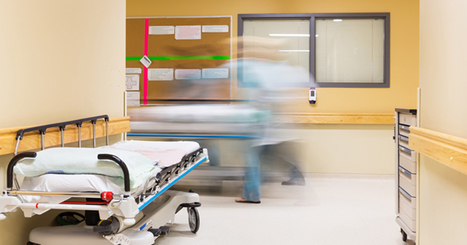The relationship between coronavirus disease 2019 (COVID-19) and myocardial injury was established at the onset of the COVID-19 pandemic. An increase in the incidence of out-of-hospital cardiac arrest was also observed. This case report aims to point to the prothrombotic and proinflammatory nature of coronavirus infection, leading to simultaneous coronary vessel thrombosis and subsequently to out-of-hospital cardiac arrest. During the COVID-19 pandemic, a 46-year-old male patient with no comorbidities suffered out-of-hospital cardiac arrest (OHCA) with ventricular fibrillation as the first recorded rhythm. The applied cardiopulmonary resuscitation (CPR) measures initiated by bystanders and continued by emergency medical service (EMS) resulted in the return of spontaneous circulation. The stabilized patient was transferred to the tertiary university center.
Electrocardiogram (ECG) revealed “lambda-like” ST-segment elevation in DI and aVL leads, necessitating an immediate coronary angiography, which demonstrated simultaneous occlusion of the left anterior descending (LAD) and right coronary artery (RCA). Primary percutaneous coronary intervention (PCI) with the implantation of one drug-eluting stent (DES) in LAD and two DES in RCA was done. Due to the presence of cardiogenic shock (SCAI C), an intra-aortic balloon pump (IABP) was implanted during the procedure, and due to the comatose state and shockable cardiac arrest, targeted temperature management was initiated. The baseline chest X-ray revealed bilateral interstitial infiltrates, followed by increased proinflammatory markers and a positive polymerase chain reaction (PCR) test for severe acute respiratory syndrome coronavirus 2 (SARS-CoV-2) demasking underlying COVID-19-related pneumonia.
Within the following 48 h, the patient was hemodynamically stable, which enabled weaning from IABP and vasopressor discontinuation. However, due to the worsening of COVID-19 pneumonia, prolonged mechanical ventilation, together with antibiotics and other supportive measures, was needed. The applied therapy resulted in clinical improvement, and the patient was extubated and finally discharged on Day 26, with no neurological sequelae and with mildly reduced left ventricle ejection fraction.
Published in MDPI (Dec. 25, 2023):
https://doi.org/10.3390/medicina60010039



 Your new post is loading...
Your new post is loading...









Simultaneous Double-Vessel Coronary Thrombosis with Sudden Cardiac Arrest as the First Manifestation of COVID-19